1430 A mushroom forager’s bible
Mushrooms of British Columbia: Royal BC Museum Handbook
by Andy MacKinnon and Kem Luther
Victoria: Royal British Columbia Museum Press, 2021
$34.95 / 9780772679550
Reviewed by Jocie Brooks
*
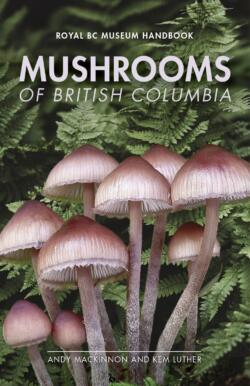 With over ten mushroom books already on my shelf, I hesitated as to whether I needed yet another guide book for fungi, but as soon as I saw MacKinnon & Luther’s Mushrooms of British Columbia I realized this was a must-have. Though there are many excellent field guides to fungi, Mushrooms of BC focuses on the most likely encountered species in our province. This is no small task, as there are over 3000 species of macrofungi (mushrooms that can be seen without a microscope) in BC. With the help of many experts, the authors chose 350 species to profile in this guide, with mention of 850 species.
With over ten mushroom books already on my shelf, I hesitated as to whether I needed yet another guide book for fungi, but as soon as I saw MacKinnon & Luther’s Mushrooms of British Columbia I realized this was a must-have. Though there are many excellent field guides to fungi, Mushrooms of BC focuses on the most likely encountered species in our province. This is no small task, as there are over 3000 species of macrofungi (mushrooms that can be seen without a microscope) in BC. With the help of many experts, the authors chose 350 species to profile in this guide, with mention of 850 species.
Author Andy MacKinnon is a mycologist (fungi expert) and co-author of six guidebooks to BC plants. He recently retired from a long career as an ecologist with the Research Branch of the BC Ministry of Forests, Lands and Natural Resources. Co-author Kem Luther, formerly of Sheridan College in Ontario, is an avid naturalist and writer with an eclectic background that includes philosophy, teaching and computer science.

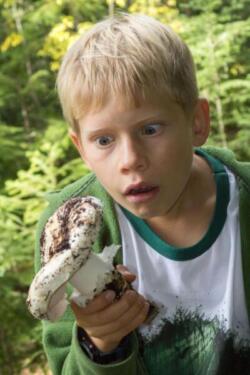
The authors state that their intent is for this to be a useful, practical guide that is both “educational and entertaining.” This is in a similar vein to David Aurora’s classic Mushrooms Demystified, which intersperses scientific information with an entertaining blend of stories, photos and anecdotes. This approach makes this book fun and accessible. I particularly like the candid photos of children and toddlers throughout the book: perched on a bracket fungus, holding a giant puffball, foraging happily with baskets in hand, or looking at a giant mushroom with rapt attention.
A concise introduction describes what fungi are, how they reproduce, and includes line drawings of identification features such as types of caps, gills and stem bases. Like other mushroom guides, fungi are placed into groups according to how they look. In the section titled “Guide to Mushroom Groups” 14 groups are identified. Not all mushrooms have gills, some have pores or spiny teeth underneath, or veins that run down the stem, like the choice edible “chanterelle” mushrooms.

Some are honeycombed with pits and ridges (morels). Others take the form of clubs, ocean-looking corals, jellies, cups, truffles, puffballs or bracket fungi. There are even fungi called the “bird’s nest” that resemble tiny nests with eggs (in this case, the “eggs” contain spores). These categories provide a great starting place, leading the reader to delve deeper into identification by examining colour, smell (many mushrooms have a distinctive odour!) taste, spore print, habitat and other distinguishing features.
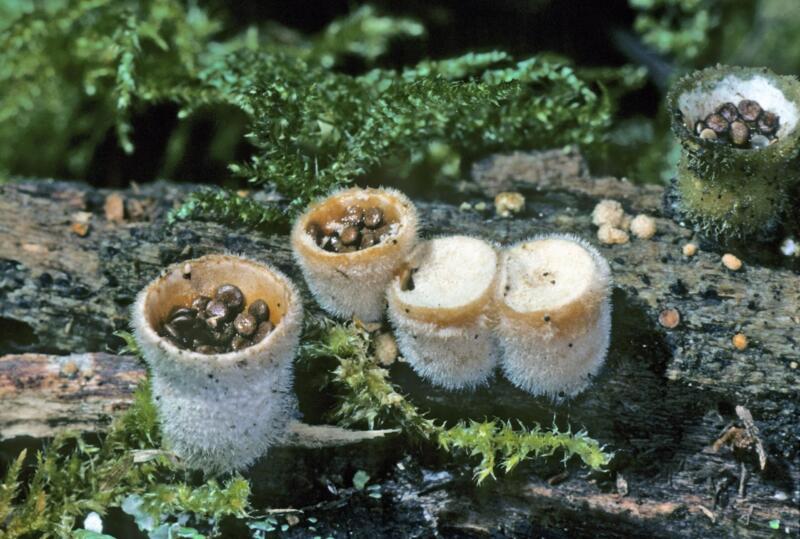
This guide does an excellent job of funnelling readers’ interest from the “big picture” down to the nitty gritty of detailed genus and species descriptions. There are great photos throughout— over 70 photographers contributed to this guide!
Between species descriptions and photos there are short essays and literary quotes. For example, you can read about fairy rings “formed by the nighttime dancing of elves and fairies” or learn about how Darwin’s daughter liked to hunt for putrid-scented “stinkhorns.” One of my favourite essays, titled “zombie ants and other horrors” describes how a species of fungi overtakes an ant, causing it climb up a tree and clasp on to a leaf, where the fungi eventually fruits from the ant’s head. Equally enjoyable was an essay about the well-known botanists Adolf and Oluna Ceska, who documented a staggering 1400 species of mushrooms from Observatory hill in Victoria.

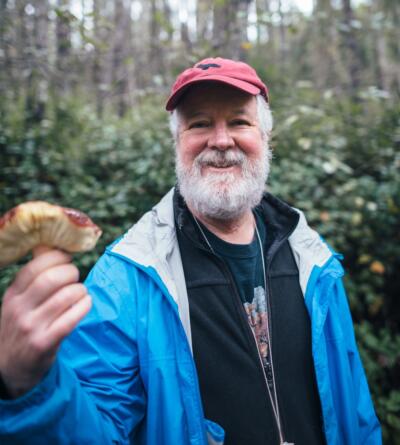
Though mushrooms with names like “funeral bell,” “deadly parasol” or “poison pax” are fear inspiring, the authors point out that there are more deaths from getting lost or injured while hunting for mushrooms, than by consuming mushrooms. I also learned that the risk of dying from eating foraged mushrooms is just as high as from eating foraged plants.
Many readers will be familiar with the historic Royal BC Museum Handbook series. Slim, informative volumes on various natural history subjects were produced by the museum starting in the 1950s. Guide to the Common Mushrooms of BC was first published in 1952, and was re-done with new authors in 1964. This new guide gives a nod to these previous publications, and even features a full page of Frank Beebe’s original 1952 illustration of a “death cap” mushroom.
The death cap (Amanita phalloides) is of course cause for serious concern. This deadly mushroom first appeared in California in the 1930s and was reported in the Pacific Northwest by the 1990s. Expert Paul Kroeger has been tracking the spread of the death cap in BC with concern. This is a mushroom that all readers should familiarize themselves with.


The perception that all mushrooms are associated with death and decay seems to be uniquely British in origin, where “fungiphobia” has a long history. The entrenched view of fungi as something dark and destructive still has a foothold in popular culture. Though some fungi are decomposers, as many as 90 percent have complex relationships with plants and tree roots. Beneath the visible mushroom or “fruiting body” are masses of stringy filaments called “hyphae.” Collections of hyphae called “mycelium” provide water and minerals to plant roots in exchange for sugars. The vast underground networks of interconnected fungi and plant roots has been dubbed the “wood wide web.”
The Netflix documentary Fantastic Fungi, featuring Paul Stamets, explores this further, as does BC author Suzanne Simard in her book The Mother Tree. Simard, a professor at UBC, did pioneer work on the connections between trees and fungi. The science tells us that fungal connections are critically important to healthy forest ecology, and we are all learning to see the forest in a new way. Numerous books and documentaries have led to an explosion of interest in fungi in North America in recent years. This fascinating and complex group of organisms seems to be having a Renaissance among the general public, even though fungi have been celebrated around the world as a source of both food and medicine for centuries.
Though the authors’ interest in fungi goes well beyond foraging for the table, edibility is a topic that occurs throughout the book, and acknowledgement is given to those who depend on income from mushroom picking. Psychedelic or “magic mushrooms” are also discussed, as well as medicinal/traditional uses of fungi by BC Indigenous peoples and in global context. Fungi are even used to dye wool, creating a spectrum of natural colours.

I found this guide to be completely satisfying on every level. The text is clear and concise and informative without being overwhelming. Photos of people, quotes and the short essays throughout provide and element of fun, whimsy and human interest. Detailed species descriptions and diagnostic photos provide plenty of scientific information for the serious fungi enthusiast. Many professionals were consulted in the creation of the book, and acknowledgement is given to experts who reviewed various sections. It is wonderfully thorough and well planned. I don’t like to judge a book by its cover, but it has a gorgeous eye-popping cover to boot! As a “field guide” it is a bit on the heavy side for the backpack, but these days many naturalists rely on identification apps and photography in the field, and consult their heavier but more comprehensive book references only after getting home or back to the car.
Given the high calibre of this book, it isn’t surprising that Mushrooms of BC has been – and remains at the time of writing — the No. 1 BC bestseller. This will be a popular and useful book for years to come, and an essential resource for fungi identification in BC. I am glad to have a copy alongside the other fungi books in my collection.
*
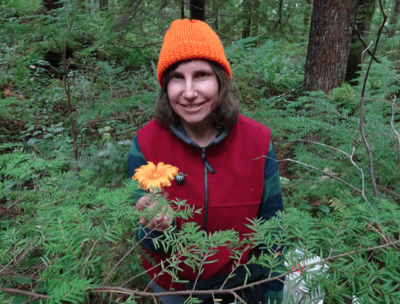
Jocie Brooks studied classical piano, and has a Bachelor of Music degree from the University of Victoria. She works as a piano teacher but moonlights as a nature nerd, with keen interests in birds, botany, fungi and conservation. Jocie enjoys reading and writing, and wrote a nature column in the local paper for many years. She lives in the Comox Valley with her two children. Editor’s note: Jocie Brooks has also reviewed books by Collin Varner, Dale Bakken & Sandra Lynch-Bakken and Megan Clendenan & Kim Ryall Woolcock for The British Columbia Review.
*
The British Columbia Review
Publisher and Editor: Richard Mackie
Formerly The Ormsby Review, The British Columbia Review is an on-line journal service for in-depth coverage of BC books and writers. The Advisory Board consists of Jean Barman, Wade Davis, Robin Fisher, Cole Harris, Hugh Johnston, Kathy Mezei, Patricia Roy, Maria Tippett, and Graeme Wynn. Provincial Government Patron (since September 2018): Creative BC. Honorary Patron: Yosef Wosk. Scholarly Patron: SFU Graduate Liberal Studies.
“Only connect.” – E.M. Forster
One comment on “1430 A mushroom forager’s bible”